It has been nearly 3 years since I solo travelled to Ladakh (and was close to dying but didn’t know that :D): the enchanting land high up in Himalayas where the visuals are breathtaking and moments magical. This was that once-in-a-lifetime trip that truly inspired me to start my own travel blog. I wanted to tell this story of how I planned this adventurous trip and how truly incredible Ladakh is. But it took me so long to finally set up my own blog and actually start writing my experiences. But since this year (2018) I pledged to keep my blog active irrespective of how many people actually read it or worrying how they’d react to it. So here is the story of my solo adventure in India’s northernmost region in the lap of Himalayas.

[dropcap]J[/dropcap]ust one word incites so many emotions and feelings: Ladakh! I have a special place in my heart for Ladakh. It is my favourite place in the world (well, of what little I have seen). This arid, incredibly beautiful and scarcely populated Himalayan wonderland is not touted as the world’s highest cold desert for nothing. At 3500 meter the air is so rare that apparent* oxygen in air is nearly 13.5% rather than the usual 21% at sea level. This reduces further if one goes to higher altitude places like the famous Pangong Tso. The summers are pleasant while the winters can be as harsh as they get. In fact in peak winter Ladakh loses all land connectivity with the rest of India. So when I decided to do a solo trip here I prepared myself well.
Tha Plan
The idea was to reach Leh by air, the largest town in the region, acclimatize for a week or so, get Inner Line Permit (ILP)§, hire a bike and then begin a circular trip to Pangong Tso to Chushul to Nyoma to Tso Moriri to Karu and back to Leh. There were alternate routes and adventurous paths I had kept on my itinerary as plan B and plan C. Those would be considered if everything went well and both me and my bike were in good shape. The plan also included experiencing the Hemis dance festival as I reach Karu. Hemis monastery where this annual festival is held is mere half an hour away from Karu.
I had taken extra care for the cold and dry Himalayan air with enough warm clothes, the precautionary pills to fight high altitude sickness and packed light so I could strap it on the backseat of my bike. I was confident or so I thought. It was only later that I realised how ill-prepared I was.

Acclimatising in Leh
So I reached Leh from Srinagar by a shared cab. What I was doing in Srinagar is itself another story but I’ll reserve that for another post. I shuddered to look down in the valley below as the cab traversed the winding curves of mighty Zoji La (La in Ladakhi langauage means a pass thus English translation as Zoji La pass is incorrect). One could also see the tiny colourful tents pitched for the Amarnath pilgrims. Baltal is the base camp for the Amarnath Yatra. There’s an interesting incident in the modern history of India associated with the pass. Indian Army, in 1948 war surprised the enemy with unexpected tank assault led right through this pass.
As the journey continued on the meandering road, in a few hours I reached the picturesque town of Leh. As I walked through the market streets filled with the travellers from all over the world my heart felt a jolt of joy. I was going to spend next 5 days in this town while I let me lungs get adjusted to the less dense mountain air. It is true and I knew that 5 days won’t be enough if I wanted to spend a long time near the lakes (which are at higher altitudes) but I wasn’t planning on staying more than a night anyway. Dreaming about next days I retired to my bed at the usual B&B I like near the Leh Palace.
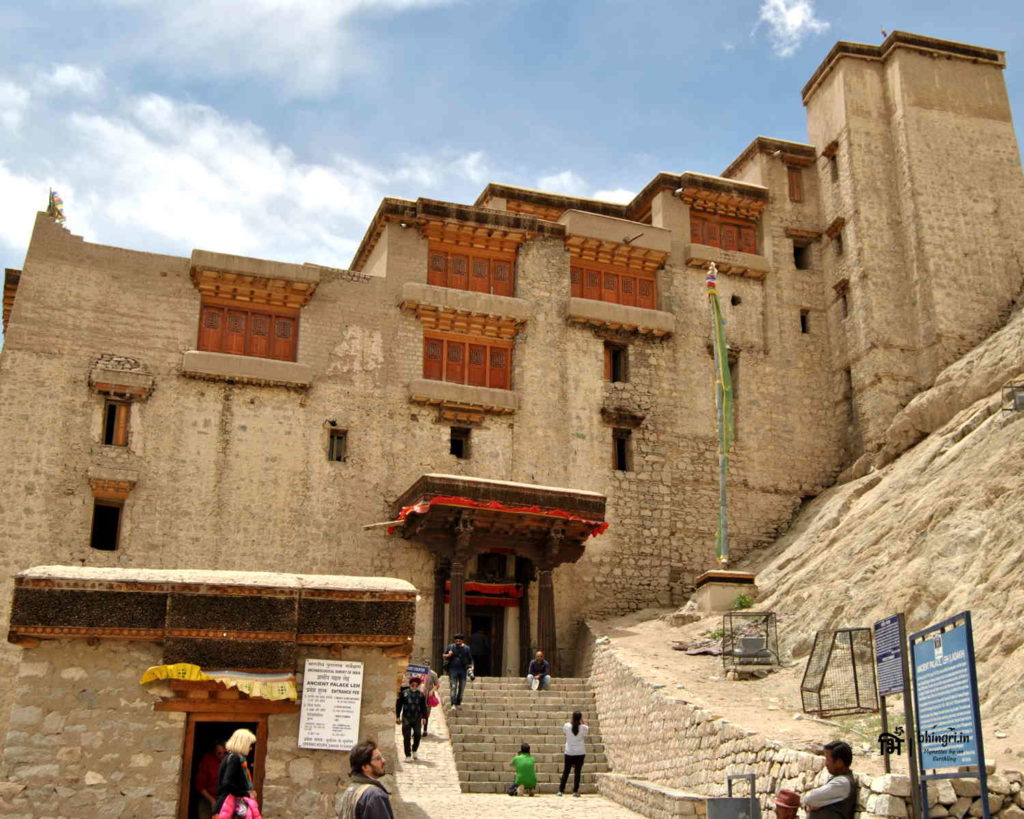
The Journey Begins
After wandering around in the narrow lanes among the traditional flat top houses of Leh, visiting the Leh Palace and eating to heart’s content I’d return to the humble home of my host. On the last day in Leh I hired a nice sturdy 350cc beast of a bike: the classic Royal Enfield. I instantly loved its feel and the roar of its engine. This new friend would help me navigate the treacherous curves in my adventure.
I had a brought a couple of ropes with me but I was unaware that hired bikes didn’t always come with luggage racks. “No worries”, I thought, “I can make it work myself”. With the help of my host I managed to attach my big backpack to the rear along with additional fuel cans. The next morning I set off onward and forward on the smooth beautiful national highway 1A and with a picturesque view to accompany. I was feeling really good.
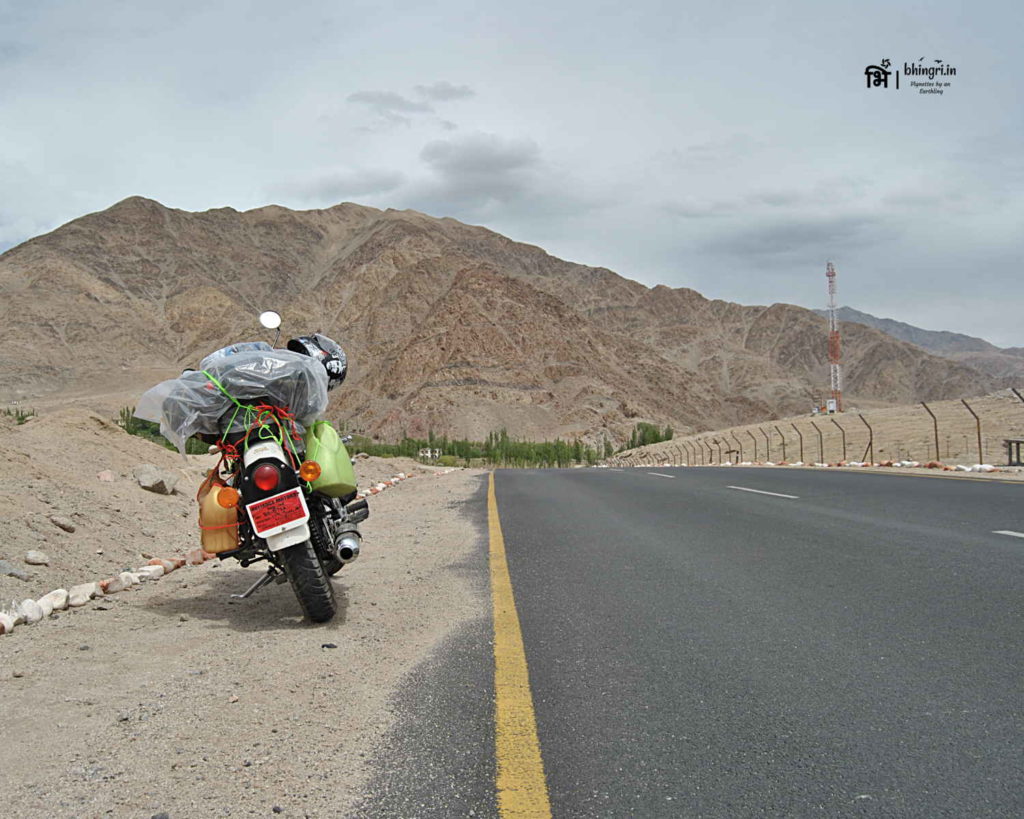
Reaching Pangong Tso
Casually meandering through the cute Ladakhi towns of Shey and Thiksey I reached Karu, a small town I’d visit again on my way back. To reach the lake I had to pass through Chang La, the only place on the road after I leave Karu where I can find something to eat. Of course I knew that fuel for my bike is as important as food for myself. I filled the cans I brought along at the fuel station before leaving Karu and now I was a feeling a bit relaxed. I had all the time in the world and I didn’t want to rush it. The quicker altitude is gained higher is the risk of catching high altitude sickness.
Carefully tracing the curves, stopping every few kilometers to click some pictures I continued. Once I left the highway, the road was bad and at many places the streams literally washed off parts of it! Thankfully I was on my bike so I could sneak past bigger vehicles and reach the lake before dark. Tso in Ladakhi means Lake. The Pangong Tso is situated at 4250m and has absolutely mesmerizing views. This is only one of the many beautiful lakes of Ladakh. It is interesting to note that only part of this lake is under India’s control while rest of it is with China after the Sino-Indian war of 1960. One can observe and even “hear” Indian patrol boats making rounds deep inside the lake.
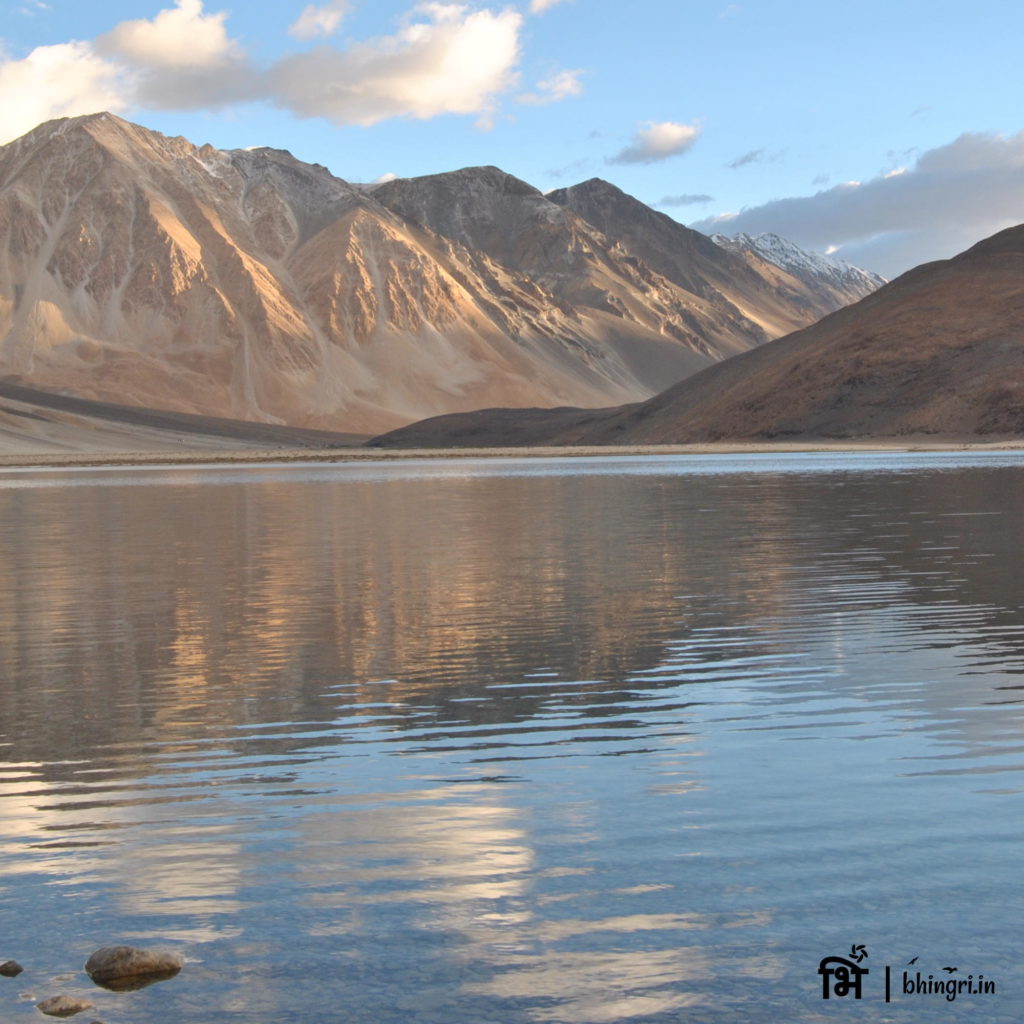
The Mesmerising Views
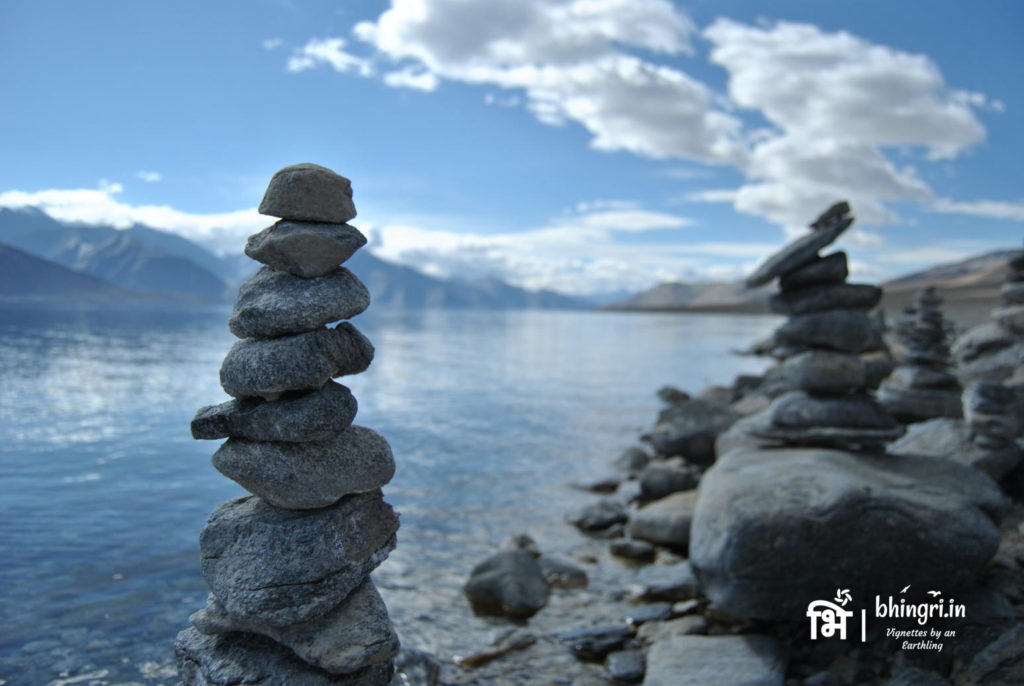
I woke up early morning much before the sun would rise and reveal the wonder sprawling in front of me. After all I had to take full advantage of the Golden Hour. I had to see with my own eyes the marvel of how the lake changes its colours as the day progresses. And boy was I swept off my feet! Pangong Tso was divine and it has left a lasting impression on me. I wish however, I was more skilled in my photography when I was there. I don’t have photographs that do justice to what I saw by naked eyes. Of course, the experience definitely improved my skills over the period.
At first only the sky illuminated with dark shades of blue. The gradient tilted to light blue, white and yellow towards the east. The huge mountains looked stunning in the reflection of the lake surface. Gradually the glimmer of light fell on the top of the mountains and the darkness started crawling down the hills. Only then I started grasping the immensity of the mighty Pangong Tso. The lake reflected the hues of blue and I just melted. How minuscule I looked standing there in awe of the miracle unfolding in front of me!
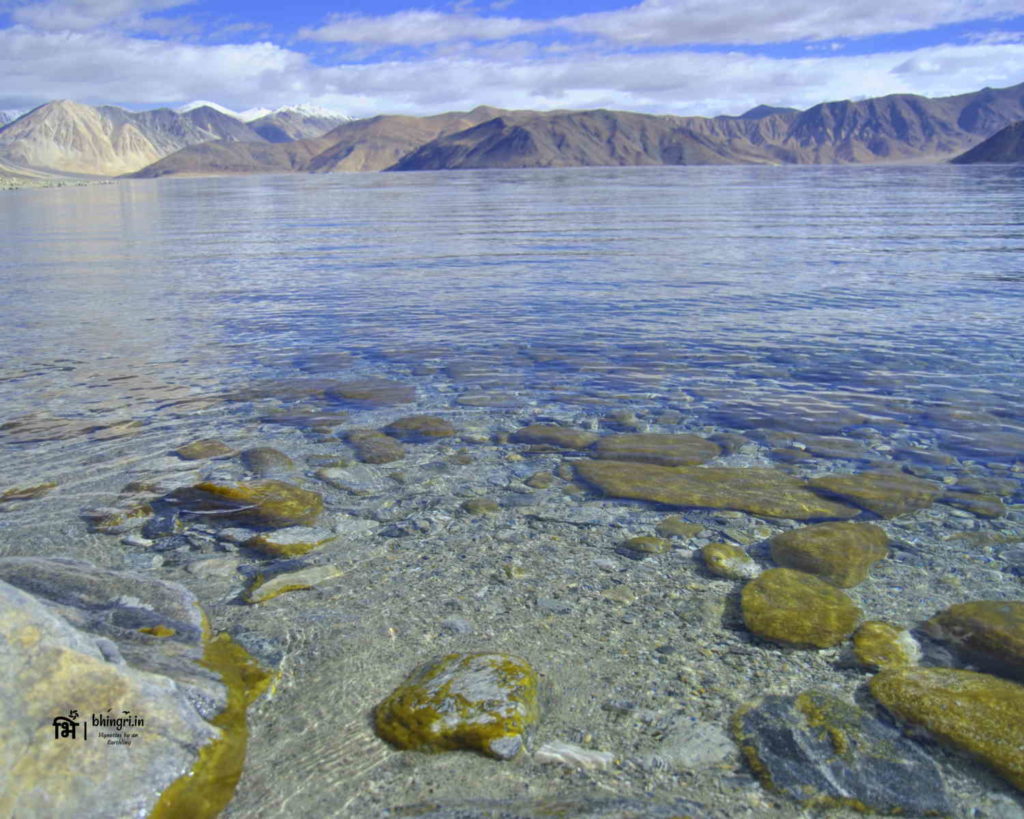
The Ordeal at Pangong Tso
The next destination was Chushul as I would continue to take the road along the banks of the sprawling lake. The cell phone reception in this region is zero. As with any other region of Ladakh, the tiny hamlets are far apart and have severe electricity shortage which means difficult to recharge batteries. Although, I knew about it and hence I prepared for it. Of course who had time to browse through social media feed in the company of such beautiful lake surrounded by snow capped mountains! I kick-started my bike and began my journey towards Chushul. The road now turned into gravel and occasional sand and I had to be careful. On the left was the blue-green lake, on the right were parched yellow-brown hills and on the road was I, smiling, raising the accelerator once in a while.
Soon I passed the town of Spangmik. I was the only traveller on the road now and not a tiniest sign of life. In a few minutes I reached a patch of land where I could only see tills of sand all over. Nothing of the road (or whatever you’d call it) was in sight. I stopped the bike to look for the right way and finally decided to continue on the track of previous vehicles that left an impression on the sand. Mistake. That was a big mistake. The track indicated a big vehicle could pass, but could my bike?
Well, it didn’t. It was stuck in the sand and the wheels weren’t getting enough traction to move. I tried my best to get it out but instead I made it worse. The ignition gave up; the bike just refused to start. No man in sight, the sun getting harsher by the minute, drinking water halved and me stuck in the sand with a huge disabled bike.
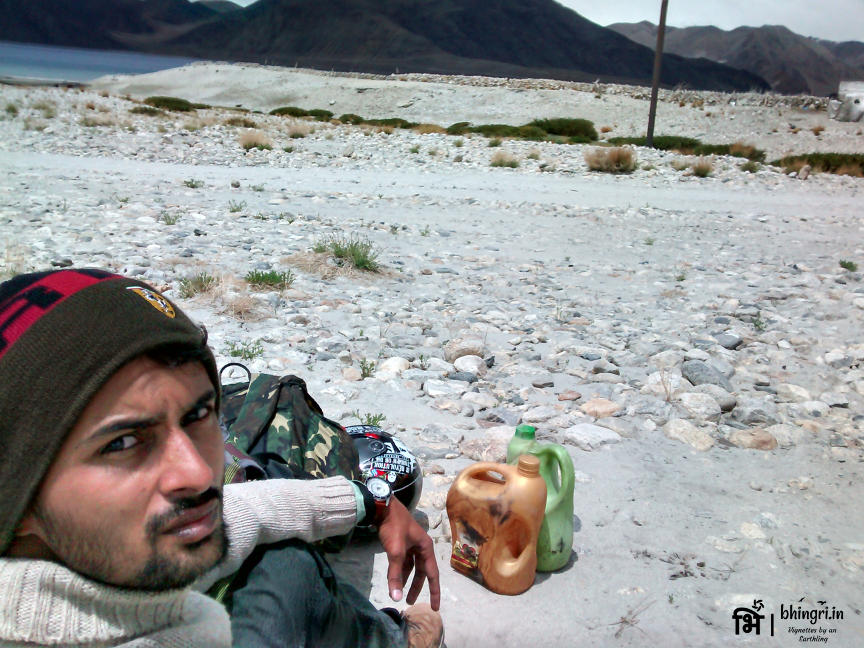
Getting out of the Situation
Luckily after about an hour I found a tourist vehicle coming my way. Only then I realised where the actual road was, right by the lake and hidden beyond the tills of sand. “Too late”, I thought. I requested them to help me push the bike on to the road and drop me off to Spangmik where I could seek some help. How I got my bike out of that muck and back to life could be a whole big post in itself. Nevertheless I was now safe and the bike was operating normally too.
Meanwhile I had spent another night at this altitude. In the morning I realised I had a bit of headache and probably a bit of temperature as well. The weather was turning bad, I could see rain approaching in the distance. I had already lost an entire day nd was already off schedule. So I decided to drop the plans to continue to Chushul and to Tso Moriri. I started my return journey. This was a wise decision. Although, before I could reach Chang La, the snow storm caught up with me. It was a hell of a ride. If I left the helmet glass open the snow would me hit me in the face and practically disable my vision. If I left it closed however it was even more dangerous as the glass deposited vapour condensate from my breath owing to drop in temperature. It was crazy.
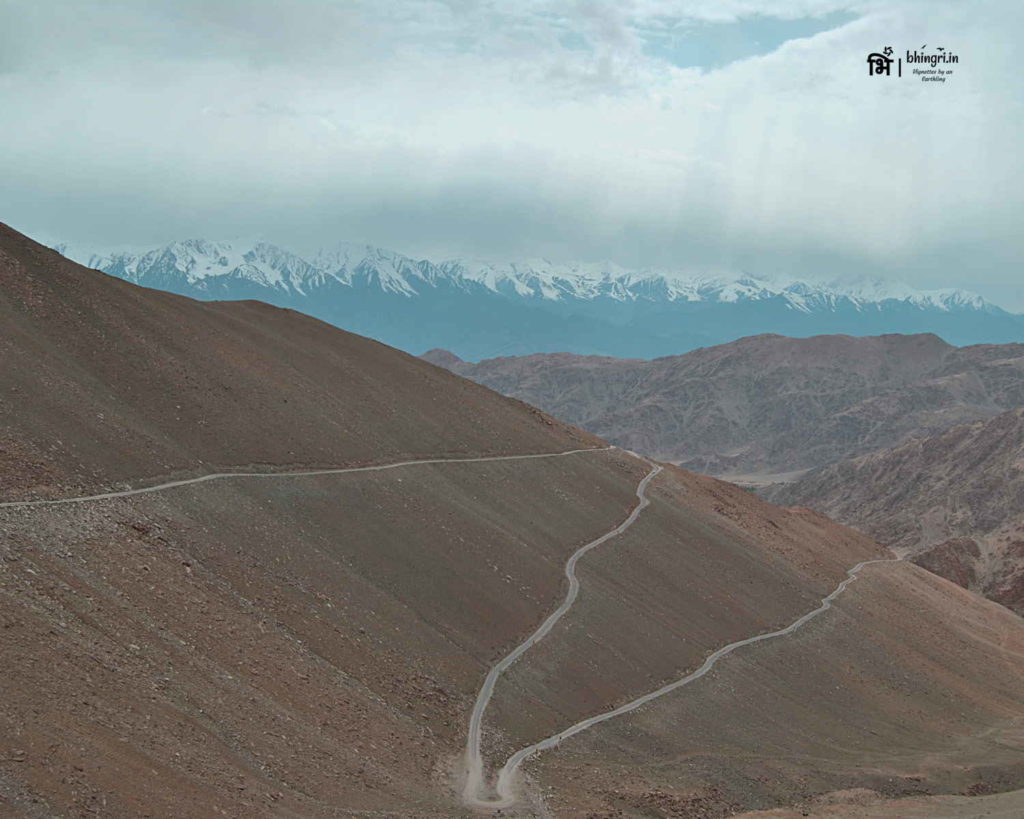
Somehow I reached Chang La. After the pass the weather was normal and I quickly reached Karu. By this time, I had severe headache. I decided to visit the Army Hospital at Karu. The conversation with the army doctor was interesting. I had indeed caught Altitude Mountain Sickness (AMS). Had I continued to Tso Moriri which is at over 4500m altitude, I could have been exposed to even less oxygen and would have suffered severe problems. I was glad I took a wise decision to return.
Hemis Festival
On the bright side, I got to attend the traditional Hemis dance festival. It was something I always wanted to experience and every bit of it was wonderful. The Hemis monastery hosts this annual festival where the monks play traditional Ladakhi instruments and masked men dance to the tune of the drums. The masked men represent various deities and mythological characters. The brightly coloured masks dancing to the high pitched drums and other instruments create an enchanting atmosphere.
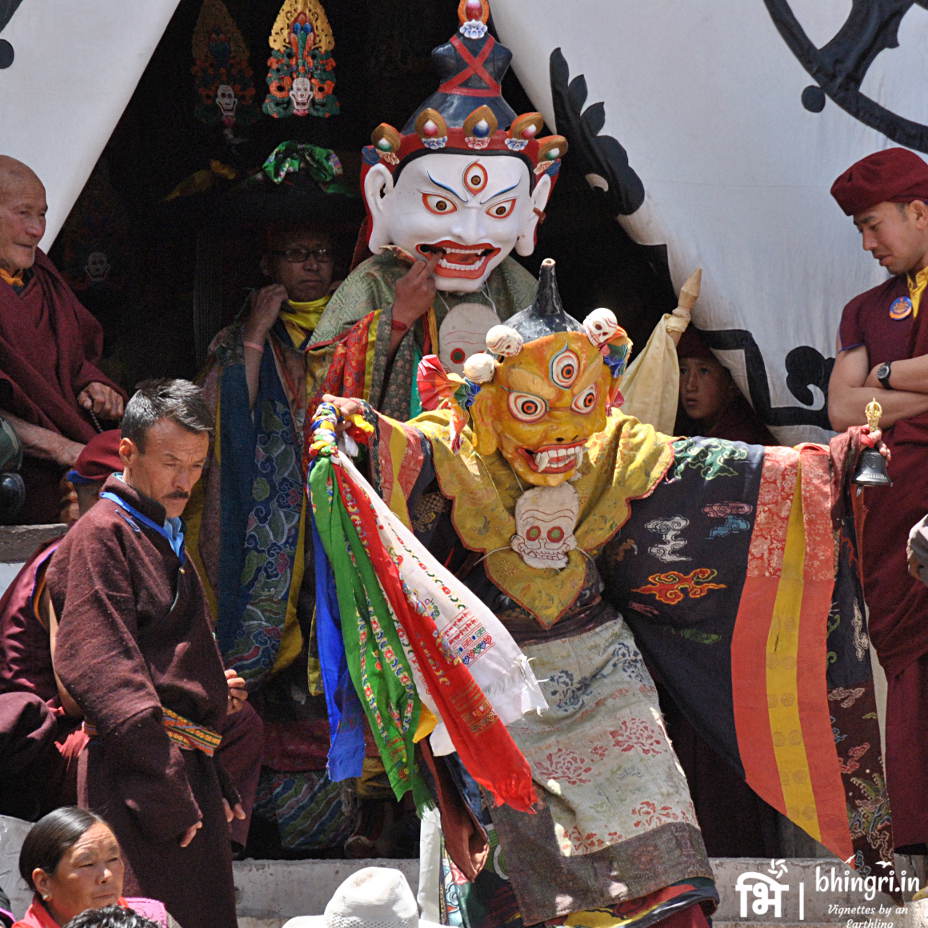
I returned halfway in this trip but I am determined to go to Ladakh again to finish what I planned. Ladakh remains to be conquered.
Have you been to Ladakh? How was your Ladakh adventure? Do comment and tell me!
*Note: It is a common misconception that air at higher altitudes has less percentage of oxygen. It is not true. The oxygen contribution in air has the same percentage (21%) at all altitudes. However, as the air pressure drops with altitude, the partial pressure of Oxygen as well does. This leads to less Oxygen being supplied to the lungs and thus the breathlessness experienced in higher altitudes. The 13.5% I have mentioned here, is the apparent Oxygen level based on drop in partial pressure. Check this informative website where they have provided a simple calculator.
§Note: The Inner Line Permit (ILP) is a permit to access sensitive areas near border and was in effect until only a few years ago. It has been relaxed to a large extent for Indian citizens and for many areas isn’t needed any more. Foreign nationals however do need it and many areas are strictly forbidden for outsiders. ILP can be obtained at Leh District Collector’s office near the Polo Ground for a fee.


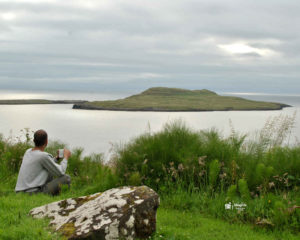
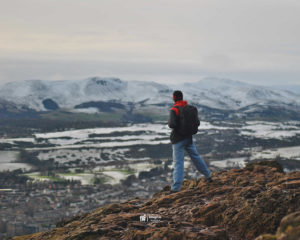
Nice one – great you got a chance to experience Hemis festival
I indeed had planned to visit it, time permitting. That was my plan B. But according to that I could attend one day, instead now I attended both days. You lose some you gain some.:)
Nice one!
That’s a detailed travelogue. Haven’t been to Ladakh yet and reconsidering my decision as I do think that it has become so touristy now a day. Let’s see!
Thanks for reading through and glad you liked it. Well, yes, I’d say that’s very true particularly about Leh and a few other places like Pangong Tso. Although, with a pinch of salt I might add that there are so many unexplored corners of Ladakh that one might explore.